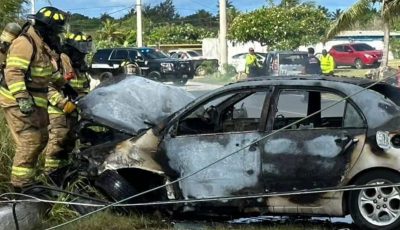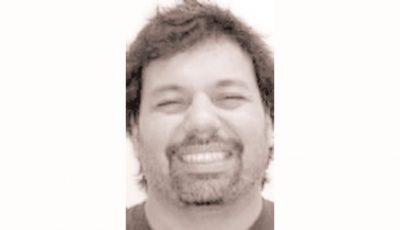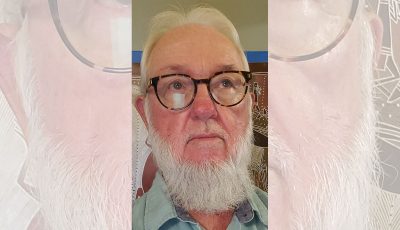Crisostomo’s convictions over rape, killing of Romero affirmed
Justices conclude that evidence pointing to Crisostomo as perpetrator was undeniably strong
The CNMI Supreme Court has affirmed the convictions of notorious habitual offender Joseph Acosta Crisostomo, who was slapped with a life sentence for the kidnapping, raping, and killing of bartender Emerita R. Romero.
In a 39-page opinion issued Friday, the high court justices said even after omitting the errors in Superior Court Associate Judge Joseph Camacho’s rulings in the case, numerous evidence remains.
“We find sufficiently strong, unrefuted evidence supporting Crisostomo’s conviction, and are unable to say, even when taken together, that it is more probable than not that the errors materially affected the verdict. We decline to reverse for cumulative error,” said the Supreme Court’s opinion penned by Associate Justice John A. Manglona and concurred by Chief Justice Alexandro C. Castro and Associate Justice Perry B. Inos.
Crisostomo, through counsel Janet H. King, appealed his convictions claiming numerous deficiencies before and during trial.
The defendant presented 10 issues: denial of expert testimony; admission of expert testimony; denial of his motion to transfer venue; failure to reiterate jury instructions at the close of evidence; admission of improper character evidence; admission of testimony based on impermissibly suggestive identification; admission of footprint evidence; use of Skype testimony; admission of testimony concerning refusal to submit to polygraph examination; and cumulative errors resulting in an unfair trial.
Then-assistant attorney general Matthew C. Baisley argued for the government before the CNMI Supreme Court. Then-interim chief prosecutor Brian Flaherty and then-assistant attorney general Margo Brown-Badawy represented the government at the trial.
On the denial of expert testimony issue, the justices ruled that Superior Court Associate Judge Joseph N. Camacho did not allow either counsel to question Crisostomo’s DNA expert Dr. David Haymer as to his methodology and its reliability, nor did the judge inquire as to these issues on his own accord, failing to establish a sufficiently developed record for the high court’s review.
The justices said Camacho unreasonably limited the evidence regarding the reliability and application of Haymer’s methodology, and, as a result, prematurely rendered his conclusion on Haymer’s admissibility.
The justices said because of this error, Camacho could not make specific findings on the record.
“The manner in which the court made its rulings was manifestly erroneous, based on an erroneous view of the law,” said the justices in concluding that Camacho abused his discretion.
The justices, however, ruled that although Camacho erred in determining the admissibility of Haymer testimony, a close review leads the high court to conclude the exclusion was harmless.
The justices said Crisostomo did not seek to introduce Haymer to testify about any evidence, rather, his testimony was sought to point out potential flaws in Federal Bureau of Investigation DNA analyst Susana Kehl’s interpretation of the DNA mixture.
The justices said although the exclusion of Haymer rendered Crisostomo’s trial imperfect, it was nonetheless fair.
“We find a fair assurance of harmlessness that the error did not materially affect the verdict: had Haymer been able to testify, it is more probable than not that the same verdict would have been returned,” said the justices, concluding that they deem the error harmless.
On barefoot morphology expert William Bodziak’s testimony, the justices said they find it evident—and certainly more probable than not—that Camacho would have nonetheless admitted Bodziak as an expert after a proper reliability determination.
“As such, we deem the failure to make findings as to the reliability of barefoot morphology harmless,” the justices said.
With respect to change venue issue, the justices found Crisostomo’s vague claim as insufficient.
The justices said discussion of certain jurors’ knowledge of the case in the news is insufficient; the constitution requires the trier of fact to be impartial, not ignorant.
“We thus defer to the province of the trial judge and find no abuse of discretion,” the justices said.
On jury instructions matter, the justices said because the judge has broad discretion in deciding to give a cautionary instruction rather than declare a mistrial and they (justices) assume the judge’s curative instruction was followed so as to overcome any prejudicial effect of a witness’ statement, they find no error.
Pertaining to identification of Crisostomo’s voice in the 911 call issue, the justices said despite the police officers’ suggestive setup, Joanne Castro, Crisostomo’s prior live-in partner of 17 years, was able to give a reliable identification, rendering the out-of-the court identification admissible.
“We find no due process violation,” the justices pointed out.
On footprint evidence, the justices concluded that the taking of Crisostomo’s footprints was not a critical stage of the proceeding and that subsequently admitting evidence of Crisostomo’s footprints did not violate his Sixth Amendment right to counsel.
The justices found no error in Camacho admitting the footprint evidence.
On Skype testimony, the justices said given that Camacho did not err in allowing David Snyder to testify via Skype, they find no plain error occurred.
Snyder is the forensic audio examiner who enhanced Romero’s 911 call.
With respect to polygraph testimony, the justices said any error in admitting the testimony about Crisostomo’s refusal to submit to a polygraph was not plain in light of the record as a whole.
“Accordingly, we find no plain error,” the justices said.
On cumulative error, the justices said they weigh the aggregate prejudicial effect of the trial errors against the sum of the evidence presented against Crisostomo.
The justices noted Camacho’s errors in four issues, particularly the denial of Crisostomo’s DNA rebuttal expert, were undeniably prejudicial.
The justices said, however, the government’s evidence pointing to Crisostomo as the perpetrator was undeniably strong.
The justices highlighted some of this evidence.
The justices said in particular, Alice Kintaro, Shaine Castro, and Crisostomo himself all identified Crisostomo as driving a vehicle matching the description of that seen by Natalie Ocon.
The justices said hair and fiber in the rented car were consistent with Romero’s hair, leggings, and fibers found on her shoe.
The justices said three individuals separately identified Crisostomo’s voice on a 911 call where Romero was heard pleading to be released, complaining that her neck hurt, and asking to pick up her pants.
The justices said without knowing either party, the 911 operator identified the female voice as Filipina and the male voice as local.
The justices said cell tower records matched Romero and Cristomo’s movement, including pinging Crisostomo’s borrowed phone in Marpi at 6am on Feb. 5.
The justices said footprints matching Crisostomo’s were found at La Fiesta next to drag marks.
The justices said Crisostomo was seen by a witness attempting to sell a Blackberry Torch shortly after.
The justices noted Kehl’s testimony of a 1 in 960 million probability that the DNA found in Romero belonged to someone in the Chamorro population other than Crisostomo.
The justices said the government notes Crisostomo has taken an “everything-but-the-kitchen-sink approach” to the appeal, and that they agree.
In addition, the justices pointed out that Crisostomo’s briefing is littered with violations of the NMI Supreme Court rules, conclusory statements, underwhelming legal arguments, and misstatements of law.
Camacho presided over the trial and decided the misdemeanor charges. He found the defendant guilty of assault and battery, and disturbing the peace.
On April 24, 2014, the jury reached a guilty verdict against the then-40-year-old Crisostomo as to the charges of first degree murder, kidnapping, sexual assault in the first degree, and robbery.
On May 28, 2014, Camacho sentenced Crisostomo to life imprisonment.
Romero, 37, was last seen boarding a car near her house in Garapan in the early morning of Feb. 5, 2012. She was supposed to meet her boyfriend in Chalan Piao. Two days later, FBI agents found her body in a small bathroom at the abandoned La Fiesta Mall in San Roque/As Matuis. Autopsy revealed she was beaten and strangled with a pair of leggings.




























